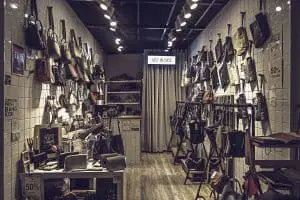Introduction
As we set out to build our fashion company, one of the most important questions to answer has to do with how we are going to build our brand. As discussed in many other posts like this one, succeeding in creating a successful brand can help you in building loyal customers and in adding a premium markup to your fashion collection.
At the same time, however, an unsuccessful position for your brand can make all of your efforts drown into the noise of a competitive industry, like the fashion industry.
We’ve done very extensive research on this topic, and in this post, we’re glad to share with you a very clear and exhaustive picture on how to build a branding strategy for your fashion firm. There are many variables to consider and many questions to answer, but as we move along in the post, you’ll see how that all of this work, will help you develop a successful business and acquire not only market space but will get you to become “first to mind” when your customers are looking for the perfect garment.
But before we move on, one thing needs to be clarified. What is a brand? As for many other elements of business, it might be easier to clarify what a brand is not.
- A brand is not a logo. A logo is a tool that identifies the brand, but it is not the brand.
- A brand is not a product. Sometimes we talk about brands as if they were different products, this is technically wrong as a brand is not the product.
- A brand is not a promise. A brand ends up serving the purpose of providing a promise of consistency, but a promise is not the brand, the brand is still something else.
So what is the brand? A brand is the gut feeling that your company is able to spark into its costumers. This gut feeling has to do with all the associations that your firm has been able to build to its brand, the stronger the associations, the stronger the brand. A brand is, therefore, the reaction that our customers have when hearing our brand, and because each reaction is unique, you will find that each customer will have a unique perception or appreciation of the brand.
As such, firms will develop their brand with every single and individual interaction with its customers, across the operations of the company, from the most outreaching, such as advertising, to the most internal, such as recruitment.
Great, now that we’ve clarified what a brand is, let’s start delving into this subject further. To help you navigate the content we’ve broken up this post in four sections, enjoy!
- What are the most important elements to consider as we build a branding strategy?
- What are the key elements of a positioning statement?
- What is your “Source of Volume” and why it matters?
- Conclusions
1. What are the most important elements to consider as we build a branding strategy?
Let’s get started. First and foremost, let’s present some background. For this post, the framework we’re going to use is called the STP framework. STP is an acronym which means Segmentation, Targeting and Positioning. What do we mean by each
- Segmentation. Segmentation means that we are going to divide the marketplace into parts, or segments, which can be defined, accessed and acted upon. This is because a firm cannot target the entire market, for economic restrictions mainly. In other words, we cannot be everything to everyone, we need to pick our battles. Segmentation is extremely important, as we compete in a very noisy market and unless we clearly understand who is it that we are talking to, it can be really hard to get through the clutter.
- Targeting. Targeting is a process that allows firms to identify specific customer profiles or “personas” which are the most likely to interact with our brand. In order to identify the right targeting strategy, marketers usually adopt demographic targeting, psychological or behavioural targeting.
- Positioning. Finally, once the market has been segmented, and the right customer profile has been chosen, a firm can develop its positioning statement, which is how the brand differentiates itself from its competitors in the market, as well as in customer’s minds.
So as we can see, a branding strategy needs to result from a very profound market knowledge that sparks from the understanding of the market and the understanding of your audience. If this is something you’d like to read more about here are some additional free resources from our blog.
- In this post, we instead focus on the market you are up against, based on the popular framework of the fashion pyramid. Identifying where you stand in relation to your competitors is essential as it allows you to identify the points of parity and the points of difference that will be necessary to create your positioning statement.
- In this post, we discuss how you can profile and segment your audience in the fashion industry. We delve into the most common segmentation criteria, as well as looking into some fashion-specific categories, which apply for instance to luxury, cosmetics, fragrances and more.
So, as it seems we already have a few variables to juggle, but it’s important to keep the focus on what matters the most. For instance, as we profile our customers, we need to keep in mind the Iceberg Model.
- The Iceberg Model. This model simply suggests that as we collect information from our customers, some information may be more useful than the rest. What you see from demographic data (age, gender, area of residence etc.) can mislead us in terms of understanding the motivations that lead our customers to buy our products. What liest beneath the surface – hence the iceberg metaphor – is what inspires the action of our customers, and these actions are connected to their values and beliefs, which are much harder to grasp, but so much more useful in developing the right branding for your fashion company.
We can now already see the first big challenge for our branding strategy. On the one end, we have to use all of the tangible assets that our firm is able to provide to us, as tools to stand above our competition, but on the other end, branding is designed to build towards an emotional reaction, as discussed in the introduction. Let’s clarify this further:
- Positioning is a Rational Strategy. This positioning relates to how a brand wants to build its positioning (spaceplace in the mind of its customers). This is a specific company strategy that wants to deliver a clear relevance and differentiation.
- Branding is an Emotional Strategy. Despite leveraging material elements, the branding of a fashion firm revolves around an emotional connotation which is articulated through words, colours, sound, designs, imagery etc.
All in all, as we build our branding, we’ll see that the goal of this process is to identify customer insight, a relevant and interesting element of purpose, that can connect our brand to values which resonate loudly with our customer.
So as we have already seen, branding is the result of a research process, that makes a firm question everything. Only when a clear awareness of what your fashion company stands for has been achieved, we can then move towards building a strong brand. As we delve into this research stage, there are many challenges that we need to overcome that might prevent us from achieving our desired outcome. The most common challenges usually relate to:
- Identifying the right targeting approach. Many times, if the targeting stage is not conducted correctly it can lead to a targeting so broad that it does not allow to identify useful information.
- Developing an insight from the demographic analysis. This might mislead us, as we may develop an understanding of our customers, which is comprised of the projections we make, rather than being based on the actual values and beliefs of our target audience.
- Our observation is too limited. If we don’t expand our vision to understand the environment into which our customer acts, then, we might miss out on understanding the broader picture.
As we’ve seen in this first section, there are many tools and elements to consider, but as we put our time and effort into asking the right questions, we will see how branding is about boiling down the value we deliver to the market and learning how we want to convey it to our most relevant customer profile.
As we progress in the post, we’ll get to talk more about how to build your positioning statement, once these reflections have helped us build a strong understanding of our company.
2. What are the key elements of a positioning statement?
Now that all of this hard work has been done, it’s time to move on towards a more operational part of the work, one where you are able to put on paper all of the more intangible benefits connected to our fashion company.
Building a positioning statement entails 4 different steps:
- Identifying your target. In this part of our positioning statement, we want to clarify who is it that we want to attract.
- Establishing a frame of reference. In this part of the positioning statement instead, we want to identify our competition.
- Establishing a point of difference. In this section, we want to specify in what ways our brand is different.
- Providing a reason to believe. In this section, we want to provide a reason for our customer to believe in our promise.
The guiding principle here is that we need to make choices, and we need to establish in what ways and for which customer type our company is able to deliver the most value, and can be the most compelling. As a result of addressing these 4 steps to building a positioning statement, we’ll get to something that looks like this:
“For [target segment and need] our [brand] is [conceptframe of reference] that [point of difference] because [reason to believe]”
As a result, we can see that being able to successfully differentiate the points of parity and the points of difference is one of the key elements to drive our positioning statement. Let’s clarify them further with a definition.
- Point of Parity. A point of parity relates to the similarities between products in the same category. A point of parity helps a brand establish all of those elements that are to be considered mandatory for a brand, in order for it to be considered a legitimate competitor in its category.
- Point of Difference. A point of difference relates to the attributes or the benefits that customers strongly associate with a brand, making it stand out in relation to its competitors.
Identifying these two sets of elements is essential to the firm, not only in terms of the immediate applications to the brand positioning but to actually identify what is its competitive advantage. Once this advantage has been identified, a fashion firm, should “dig a moat” or in other words, make sure that this advantage cannot be easily copied by competitors.
Again as we work towards building the perfect positioning statement for our brand, let’s remember not to close up ourselves in a corner, but instead, we need to make sure that our company is able to compete in a space where we can have a broad source of volume. What do we mean with the source of volume? This will be clarified in the next section.
3. What is your “Source of Volume” and why it matters?
When drafting our positioning statement, it can be easy to limit our branding to a market which relates to the specific product we’re selling. This, however, is a mistake, as customers don’t look for solutions which are connected to a specific product, they experience needs that are much broader and harder to define.
- In this sense, our source of volume, is the connection between the specific good we’re offering the overarching need that that product can be capable to satisfy. Let’s make an example.
When thinking about luxury goods for instance, despite the fact that we might be buying a pair of shoes, a dress, a hotel room or an expensive car, the need we’re satisfying is only partially connected to the specific properties or features of the product, as luxury goods, for instance, connect to a wide set of aspirational values, which are usually described as fitting in or standing out. In the case of fitting in, we want to show how our clothing – for instance – shows belonging to a particular identity or social class, whereas the standing out idea has to do with differentiating ourselves form the masses. In this sense, we can see that the source of the volume of luxury fashion, is connected to the customer’s identify, rather than to the specific accessory or garment.
As a result of this additional layer, or understanding of branding strategies, we can see how managing all of the interactions of a brand with its customers can be difficult unless we have a clear blueprint of what managing the brand entails. For this reason, fashion firms can use a variety of tools and frameworks, like for instance the brand house.
- A brand house is a tool which allows companies to develop a blueprint of everything you will communicate about your brand, and this allows you to be coherent in all of the implicit and explicit communications and interactions with your customers.
This is an essential tool to help marketers manage something which, as discussed throughout the post, is extremely dynamic and personal to each and every customer you’re developing a conversation with.
Let’s now move to the conclusive section of this post and look at some concluding remarks.
4. Conclusions
At the end of the day, all of the tools discussed in this post can seem overwhelming, but don’t worry, they’re simple guideposts, designed to help you think with the right mindset so that over time your brand is coherent and effective in delivering the values that you stand by.
A brand ultimately needs to simply do three things:
- Connect with the value you are bringing to the market.
- Have a clear personality, which invites customers to engage with it.
- Show a purpose which is larger than anything it may be selling.
If you’re simply able to check these three boxes you’ll see how in the end, the brand will be where it needs to be, both out in the market, and in the mind of your customers.
If you’re interested in learning more about the Fashion Industry, don’t hesitate to take a look at our course “The Fashion Industry: Explained”. Our in-depth class covers a wide range of topics spanning from understanding fashion customers and markets to developing immersive retail experiences for your customers. Here’s a link to the course, if you use the discount code BLOG20 you can access a 20% discount. Enjoy!







